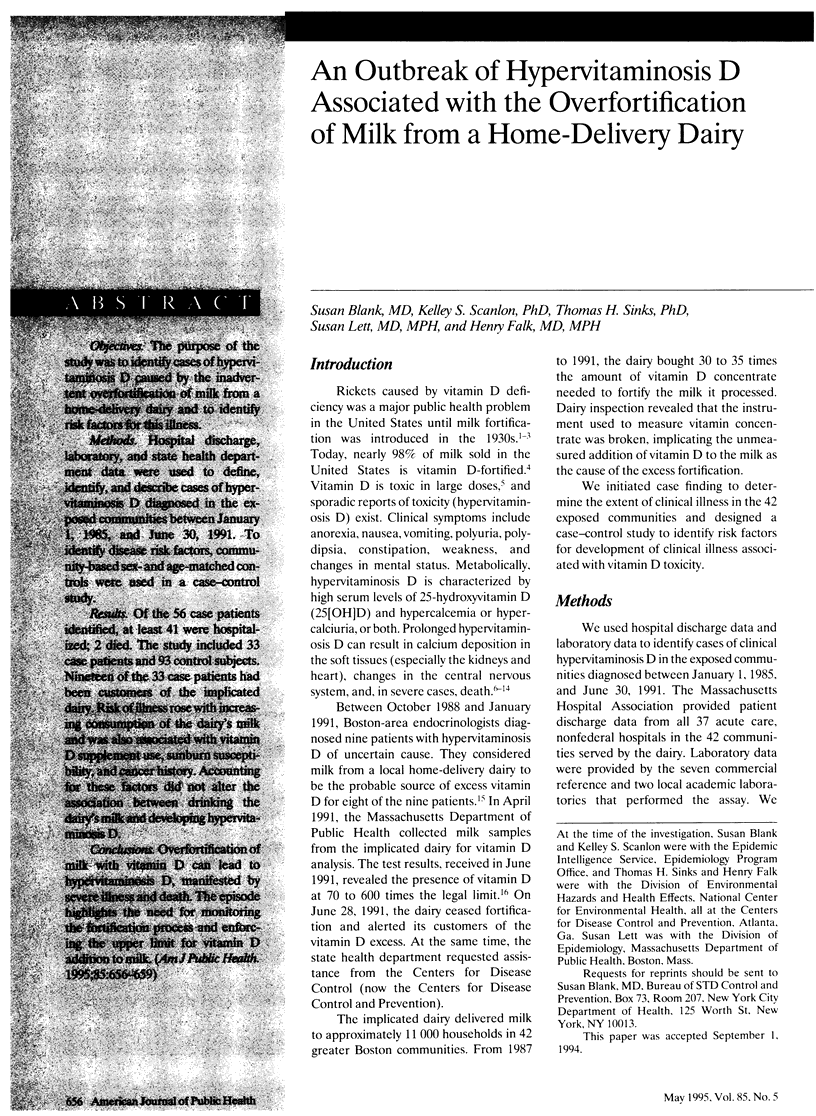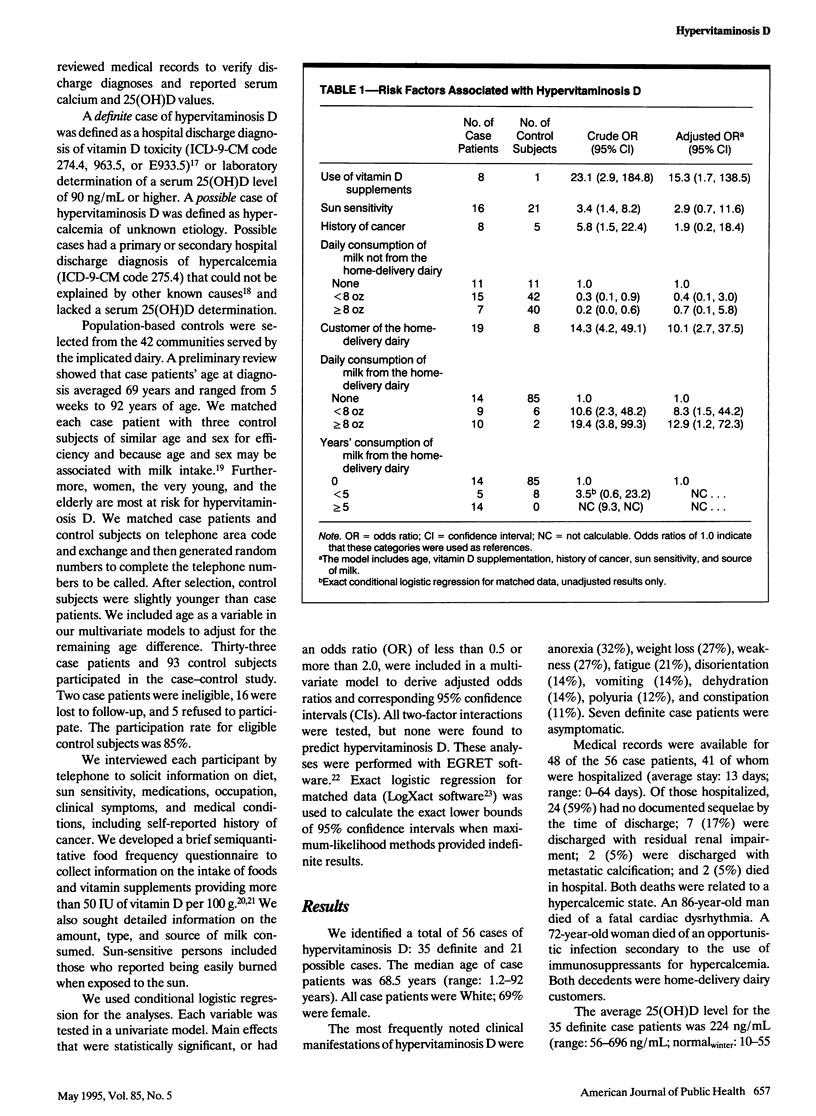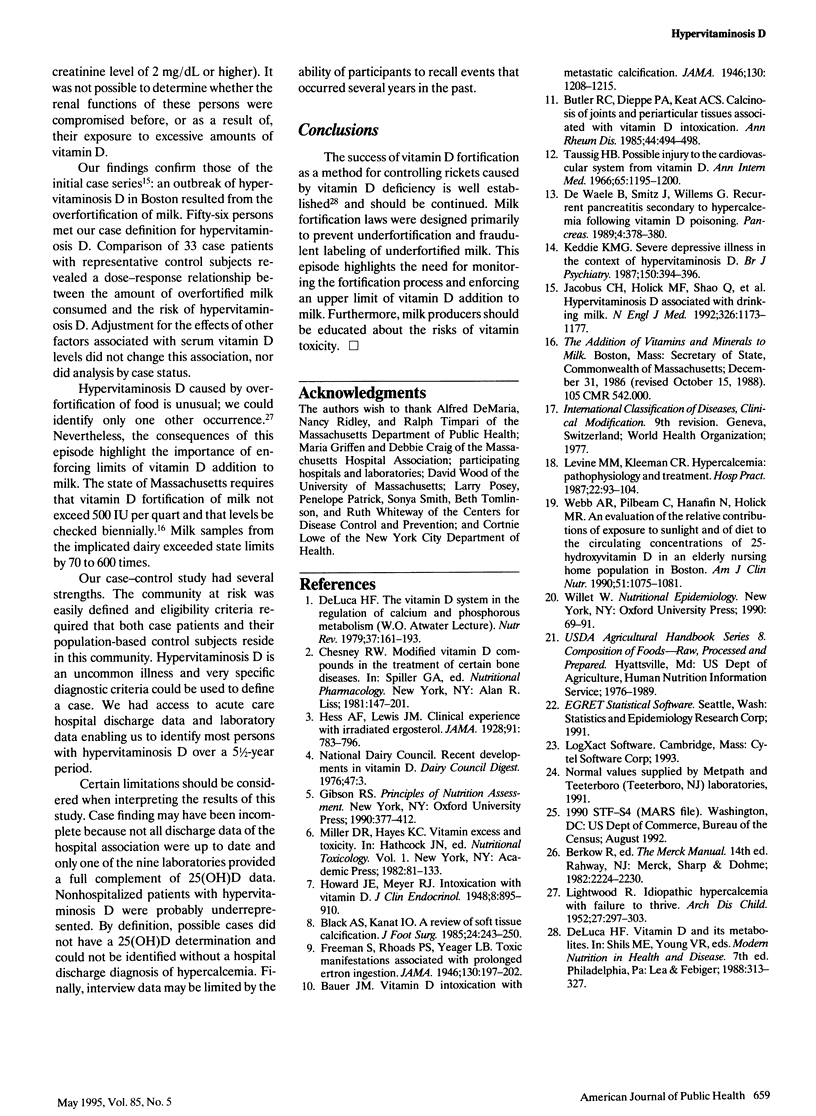Abstract
OBJECTIVES. The purpose of the study was to identify cases of hypervitaminosis D caused by the inadvertent overfortification of milk from a home-delivery dairy and to identify risk factors for this illness. METHODS. Hospital discharge, laboratory, and state health department data were used to define, identify, and describe cases of hypervitaminosis D diagnosed in the exposed communities between January 1, 1985, and June 30, 1991. To identify disease risk factors, community-based sex- and age-matched controls were used in a case-control study. RESULTS. Of the 56 case patients identified, at least 41 were hospitalized; 2 died. The study included 33 case patients and 93 control subjects. Nineteen of the 33 case patients had been customers of the implicated dairy. Risk of illness rose with increasing consumption of the dairy's milk and was also associated with vitamin D supplement use, sunburn susceptibility, and cancer history. Accounting for these factors did not alter the association between drinking the dairy's milk and developing hypervitaminosis D. CONCLUSIONS. Overfortification of milk with vitamin D can lead to hypervitaminosis D, manifested by severe illness and death. The episode highlights the need for monitoring the fortification process and enforcing the upper limit for vitamin D addition to milk.
Full text
PDF



Selected References
These references are in PubMed. This may not be the complete list of references from this article.
- BRITISH Paediatric Association; proceedings of the twenty-third general meeting. Arch Dis Child. 1952 Jun;27(133):297–303. doi: 10.1136/adc.27.133.297. [DOI] [PMC free article] [PubMed] [Google Scholar]
- Black A. S., Kanat I. O. A review of soft tissue calcifications. J Foot Surg. 1985 Jul-Aug;24(4):243–250. [PubMed] [Google Scholar]
- Butler R. C., Dieppe P. A., Keat A. C. Calcinosis of joints and periarticular tissues associated with vitamin D intoxication. Ann Rheum Dis. 1985 Jul;44(7):494–498. doi: 10.1136/ard.44.7.494. [DOI] [PMC free article] [PubMed] [Google Scholar]
- DeLuca H. F. The vitamin D system in the regulation of calcium and phosphorus metabolism. Nutr Rev. 1979 Jun;37(6):161–193. doi: 10.1111/j.1753-4887.1979.tb06660.x. [DOI] [PubMed] [Google Scholar]
- Jacobus C. H., Holick M. F., Shao Q., Chen T. C., Holm I. A., Kolodny J. M., Fuleihan G. E., Seely E. W. Hypervitaminosis D associated with drinking milk. N Engl J Med. 1992 Apr 30;326(18):1173–1177. doi: 10.1056/NEJM199204303261801. [DOI] [PubMed] [Google Scholar]
- Keddie K. M. Severe depressive illness in the context of hypervitaminosis D. Br J Psychiatry. 1987 Mar;150:394–396. doi: 10.1192/bjp.150.3.394. [DOI] [PubMed] [Google Scholar]
- Levine M. M., Kleeman C. R. Hypercalcemia: pathophysiology and treatment. Hosp Pract (Off Ed) 1987 Jul 15;22(7):93–110. doi: 10.1080/21548331.1987.11703271. [DOI] [PubMed] [Google Scholar]
- Taussig H. B. Possible injury to the cardiovascular system from vitamin D. Ann Intern Med. 1966 Dec;65(6):1195–1200. doi: 10.7326/0003-4819-65-6-1195. [DOI] [PubMed] [Google Scholar]
- Waele B. D., Smitz J., Willems G. Recurrent pancreatitis secondary to hypercalcemia following vitamin D poisoning. Pancreas. 1989;4(3):378–380. doi: 10.1097/00006676-198906000-00017. [DOI] [PubMed] [Google Scholar]
- Webb A. R., Pilbeam C., Hanafin N., Holick M. F. An evaluation of the relative contributions of exposure to sunlight and of diet to the circulating concentrations of 25-hydroxyvitamin D in an elderly nursing home population in Boston. Am J Clin Nutr. 1990 Jun;51(6):1075–1081. doi: 10.1093/ajcn/51.6.1075. [DOI] [PubMed] [Google Scholar]


